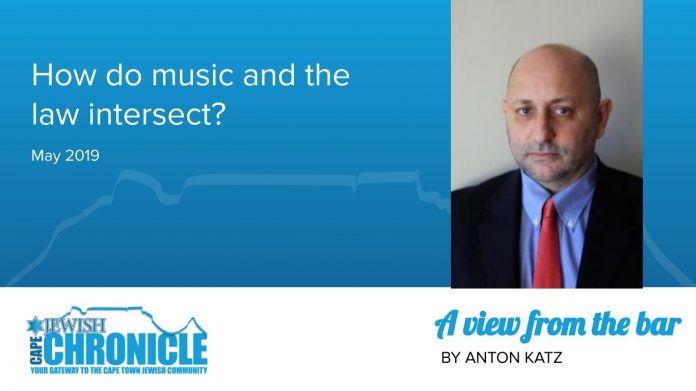By Anton Katz
There are the formal ways and then the possible ‘new’ ways of thinking.
Music law covers a range of traditional legal subjects. These include intellectual property law (for example copyright law, trademarks, image publicity rights,), competition law, commercial and insolvency law, contract law, defamation and, for the live events industry, immigration law, health and safety law, and licensing, and lastly censorship laws (remember the banning of singing apartheid protest songs.) Many millions of rand and dollars and reputations depend on how the law deals with issues involving music.
A most famous case in contract law cited all over the world concerns an opera singer. Opera singer Johanna Wagner agreed and was engaged by Benjamin Lumley to sing exclusively at Her Majesty’s Theatre on Haymarket from 1 April 1852 for 3 months, two nights a week. Frederick Gye, who ran Covent Garden Theatre, offered her more money to break her contract with Mr Lumley and sing for him.
Lumley went to court to seek an order restraining Johanna from singing at Covent Garden, and compelling her to sing at Haymarket. The case was about: Can a person legally compel someone to complete his/her part of the bargain? Or, put another way, if someone refuses to perform a contract, can you take that person to court and get a judge to order him/her to do what he promised to do?
In 1852 the court, Lord St Leonards LC, declined to force Johanna Wagner to sing at Haymarket, but prohibited her from singing at Covent Garden. The court found that he had no power to compel an opera singer to perform under her contract.
Specific performance of a contract could not be granted if the performance was of a personal nature, like playing music or singing in a show. If the performance of the contract is not personal then a court generally can order performance; obvious examples are compelling of the delivery of a motor vehicle that has been sold, or transfer of property.
During the Holocaust, European Jews, amongst others, were persecuted and forced to live in inhumane conditions. In the ghettos and concentration camps, they lived with constant hunger, sickness and fear of death.
Even under these terrible circumstances, some managed to play music and compose new songs.
Music is a universal language that has the power to express what cannot be told or explained in words. The music that was performed or composed during the Holocaust, provided some souls with a touch of emotional comfort and distraction from their horrific reality: “music gave us so much, to escape even for a few moments to a ‘normal’ world” explains Greta, a survivor from ghetto Terezin. Though they could not escape from their physical reality “music allowed us a complete disconnect and emotional escape from the daily life.”
Indeed, music had the power to save people’s lives during the holocaust. Music of diverse origin and style were performed and composed during the Nazi period.
The Nazi Party itself made widespread use of music at rallies and public events, particularly marching music and rousing propaganda songs. The Nazis highly valued music and often gave special treatment to those who had the skill to play an instrument.
The Nazi’s appreciation of music allowed some imprisoned musicians to get better jobs, better living conditions, more food and clothing. In many ghettos and camps, people who played an instrument were selected to join the local band or orchestra. Some musicians were forced to entertain the Nazis.
The travesty of musicians who were forced to play in the concentration camps would haunt them forever. Many played as they watched their family and friends march into the gas chambers. The ‘useful’ skill of those musicians was a horrific and traumatic experience, but one that often saved their lives: “the cello really saved my life because to be in this orchestra was a way of survival, because as long as they wanted music they would be foolish to put us in the gas chambers” explains Anita, a survivor from Auschwitz.
The logo of the Greenlandic Judiciary is a drum with a drumstick, and in the drum are two figures. This logo draws on the Eskimo tradition of song-duels, one of the devices used to ‘solve’ conflicts between individuals. The drum hangs on the walls of magistrates’ courtrooms throughout Greenland.
In western legal systems, which have generally cut out or ignored the cultural and ‘musical’ components of law, have also to a large degree excluded and ignored emotionality in law. Western notions of justice include Lady Justice weighing scales and cutting out and off with the sword.
Emotion is not part of the law. But should the law ignore emotions and human frailty; perhaps a more creative way of creating societal balance and ecological sustainability is through music. Law is after all merely a tool to achieve justice, peace and harmonious conditions for all.
Friedrich Nietzsche sums it up so well: “And those who were seen dancing were thought to be insane by those who could not hear the music.”
Click here to download a PDF of the May edition of the Chronicle
Click here to read the editor’s column for May
Click here to read more by Anton Katz











